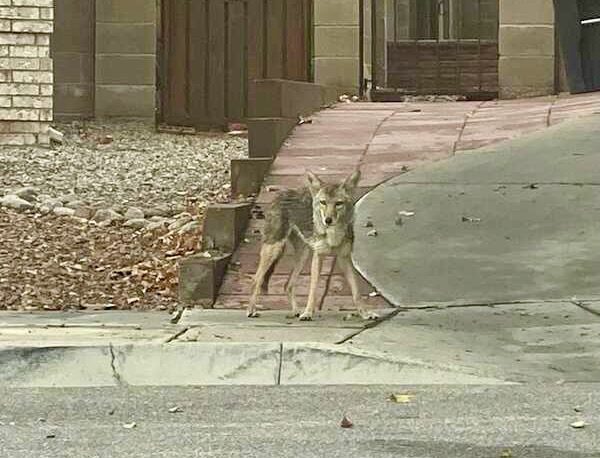From foxes to coyotes to mountain lions, residents in the far Northeast Heights regularly post pictures and videos of wildlife in their neighborhoods on social media. Most of the time the animals pose no danger to humans, but sometimes they can be a nuisance or spread disease.
On May 24, the New Mexico Department of Health reported finding five rabid wild animals at or near residences acting aggressively toward people in the southwest part of the state. The animals included three foxes and two bobcats. Albuquerque’s Department of Environmental Health recommends leaving the animals alone, reporting them to the city or calling the New Mexico Department of Game & Fish.
Foxes
On Thursday one Heritage Hills resident spotted a fox not too far from Barstow Park and earlier this year another, or possibly the same one, was caught on camera near Heritage Hills Park. According to the city’s Department of Environmental Health, the “Gray Fox are a fairly common, yet rarely seen, wildlife species in the Albuquerque area.”
The department recommends leaving the animal alone unless it is injured, sick or if it is under a house or porch. In those cases, contact the New Mexico Department of Game & Fish. Environmental Health says on its website that the “Gray Fox are a protected state furbearer and trapping should not be attempted without the guidance of the New Mexico Department of Game and Fish.”
Coyotes
On June 10, Gary Lueck of North Domingo Baca posted a photo of a coyote near the west entrance off Louisiana into the Eagle Spring Community. “Hopefully this rain will result in some watering holes up in the foothills for these thirsty critters,” Lueck wrote in a direct message.
On June 22 Aaren Hanson of West La Cueva posted four photos of a coyote roaming the neighborhood near Carmel and San Gavilon. “Doesn’t seem to startle much and has been loitering for a couple hours,” Hanson wrote.
Environmental Health recommends leaving coyotes alone unless they are aggressive or residents suspect it is sick or injured. The department says to report coyotes to the city and to actively haze the creatures if they are on private property. Hazing involves scaring the coyote away by using noisemakers, light and motion. Leave plenty of room for the animal to get away and remove any attractants from the yard.
Although coyotes will eat carrion and small pets, they are not as great a threat to humans or livestock as some people think. According to National Geographic, a nationwide eradication program led to the killing of some 6.5 million coyotes between 1947-56. Today, many states allow for the hunting and killing of an unlimited number of coyotes. Project Coyote says about 42% of coyotes are killed by aerial gunning, 28% die from trapping, 12% from being poisoned and 14% from being shot. Killing by hounds, calling, spotlighting and den eradication make up the remaining number of ways coyotes are killed.
Despite attempts to eradicate the animal, coyotes are now greater in numbers and inhabit larger areas than ever before, occupying areas as far north as Canada and as far south as Panama. When coyote populations are suppressed, they change their breeding habits to produce more pups and use their yips and howls to get a sense of how many other coyotes are in the area. Coyotes thrive in urban areas because of hunting restrictions in city limits and from the ample food supply of rats and mice that humans attract.
Mountain lions
Mountain lions can be more of a threat to humans and pets than other wildlife, but they do not always make their presence well known. On Thursday, June 23, a video of a mountain lion in someone’s backyard near Paseo del Norte and Tramway was posted on Facebook, and on Wednesday another mountain lion was captured on video in a backyard near San Pedro and Paseo del Norte.
The Department of Environmental Health website says, “Mountain Lions are rarely encountered within the Albuquerque City limits. If you do see a mountain lion in the City report it to the New Mexico Department of Game and Fish. If it is an emergency, contact 911.”
The New Mexico Game & Fish website says mountain lions, also called cougars or pumas, are most active at night, from dusk to dawn, but sometimes travel and hunt during the day. “Cougars prefer to kill prey by ambush rather than pursuit, and use a powerful bite below the base of the skull to break the necks of prey,” NM Game & Fish report. “Given the opportunity, cougars will prey on livestock, domesticated animals or household pets.”
Bears
A June 13 NM Game & Fish press release says drought conditions may increase the chance of bear encounters throughout the state. “The state has experienced less than average precipitation for this time of year, which means that bears may be in search of other food sources,” said Rick Winslow, bear and cougar biologist with the department. “Droughts historically have led to a lot of bear conflict, not only at camping and picnic sites, but also in more populated areas.”
New Mexico Game & Fish recommend staying calm and slowly moving away from the bear and making noise, so the bear knows you’re there. Give the bear plenty of room to escape and never get between a bear and its cubs. Also, pick up any children so they do not run and make yourself appear large by holding out a jacket. “If a black bear attacks you, fight back using anything at your disposal, such as rocks, sticks, binoculars or even your bare hands,” NM Game & Fish suggest. “Aim for the bear’s nose and eyes.”
The city’s Environmental Health department says, “Black Bears are an occasional visitor to the City of Albuquerque. The animals come down from the mountains in search of food during poor production years in their normal habitat.” The department recommends calling NM Game & Fish or 911 if it is an emergency.
Common wildlife in Albuquerque
Other animals commonly seen in and around Albuquerque include bats, bobcats, eagles, hawks, owls, falcons, porcupines, skunks, snakes, squirrels, rabbits and raccoons. To learn more about how to respond when encountering urban wildlife, visit the Environmental Health department’s website. The phone number for the urban biology division is 505-452-5300. To contact NM Game & Fish, call 505-222-4700.


